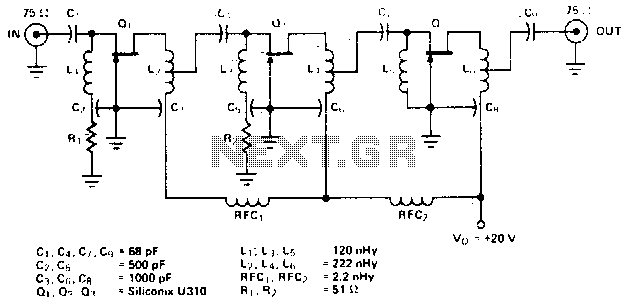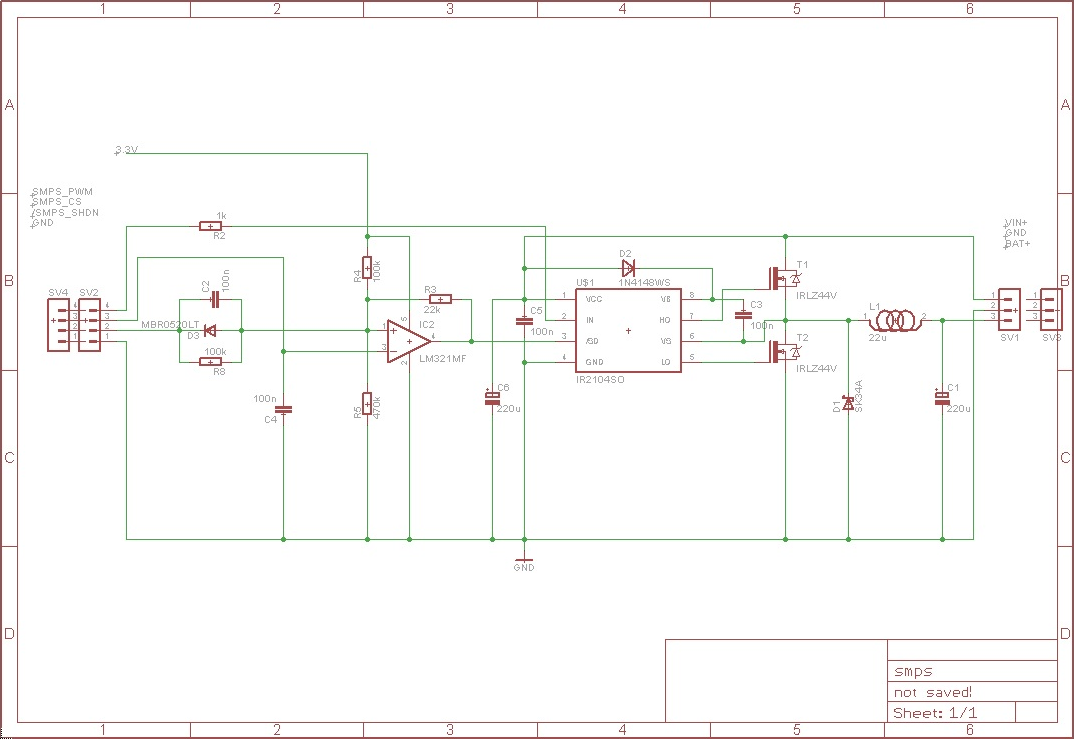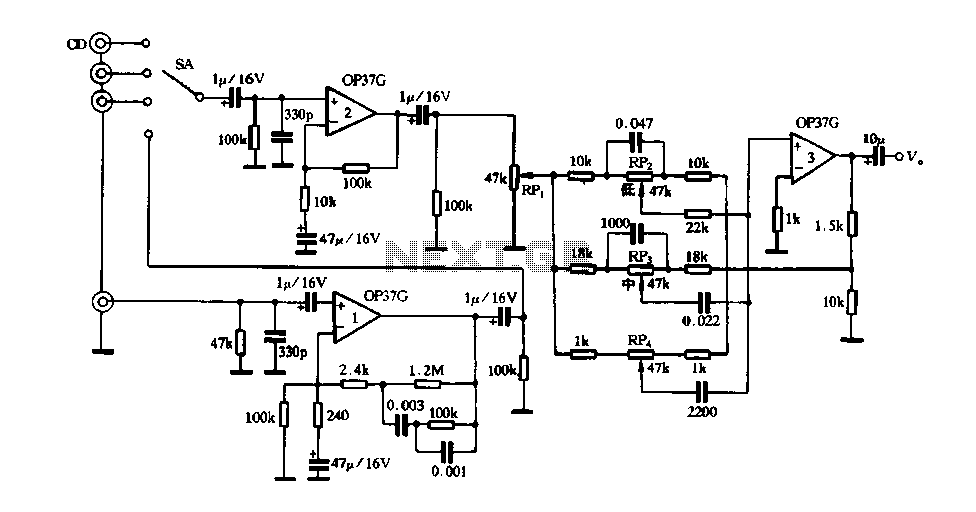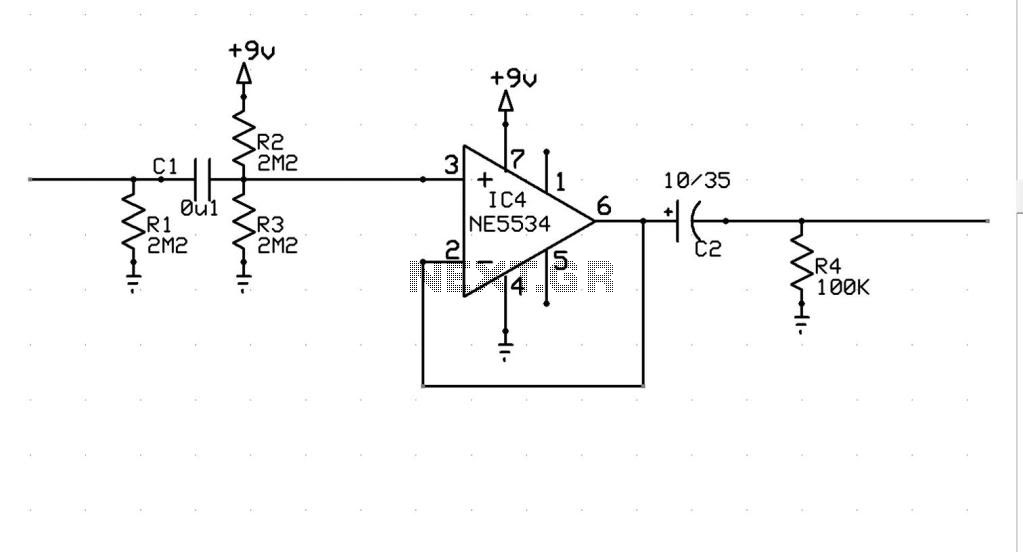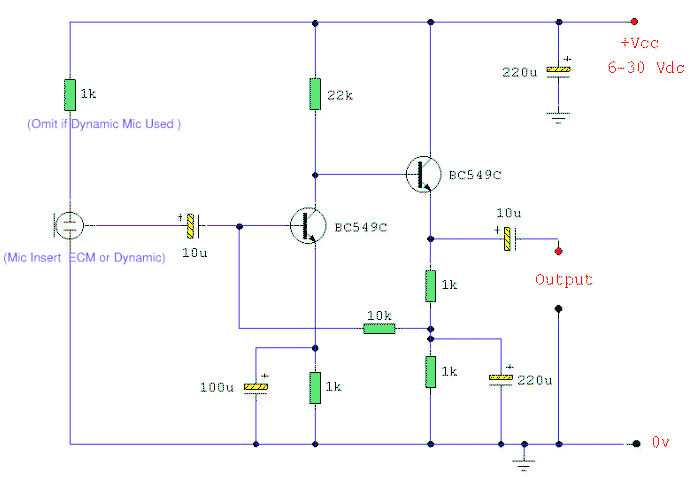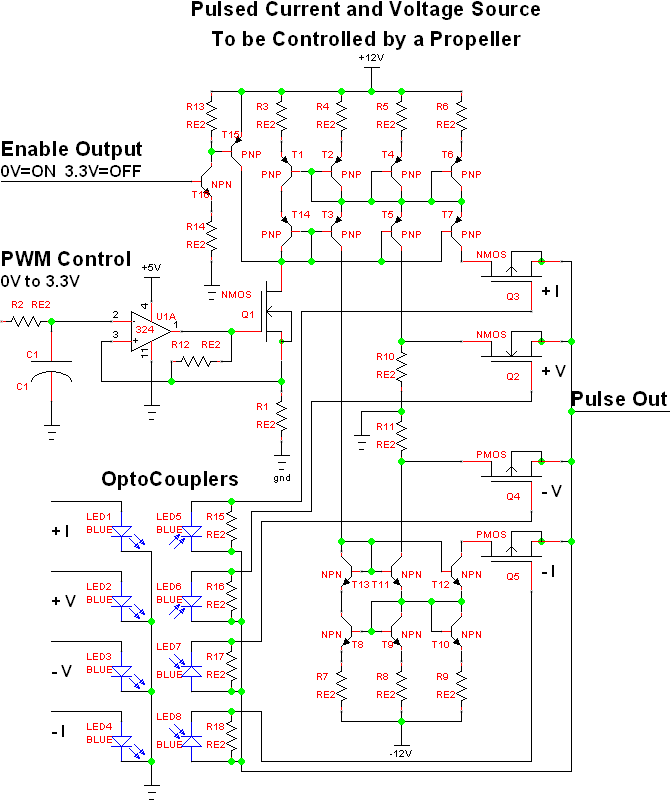
GaAs FET preamp

The goal is to construct a Gallium Arsenide Field Effect Transistor (GaAs FET) preamplifier that provides high gain and minimal noise using commonly available components. This preamp is designed to maintain stability across various source and load conditions. The circuit is assembled in a "dead bug" style on a printed circuit board (PCB) to ensure a solid ground plane. The FET is mounted on a support made from copper or brass shim stock, which is bent into shape to accommodate the source capacitors and the FET. Leadless discs or chip capacitors are employed for the source and output capacitors. Standard practices for very high frequency (VHF) and ultra-high frequency (UHF) applications should be followed. It is recommended to keep the power and radio frequency (RF) sections of the preamp separate, potentially using a shield or compartment for the power supply. If a double-sided PCB is used, the power supply section may be constructed on the underside of the preamp, although this is not advisable when the board is placed on the lid of a "Bud Box," which is a common construction method for this type of preamp. The transistor stand is bent at intervals of 1/8", ½", and 1/8" to form a specific shape. The component values shown in the schematic remain consistent across frequency bands. The transistor used (Q1) is a Mitsubishi GaAs FET from the MGF 1200, 1300, or 1400 series, with the MGF-1402 being a preferred choice. The completed preamp should be housed in a shielded enclosure, particularly if it is to be deployed at a repeater site. Alternatively, the circuit may be integrated into the receiver cabinet. Noise figure tests conducted with professional equipment indicated that the noise figure is typically between 0.40 and 0.45 dB, with a maximum of less than 0.5 dB. The gain is approximately 24 dB at 2 meters, with slightly lower gain at 220 and 440 MHz. The circuit exhibits excellent stability when high-quality connectors are utilized, with N-type or high-grade Teflon BNC connectors recommended for the 440 model.
To construct the GaAs FET preamplifier, the following considerations should be taken into account:
1. **Component Selection**: The choice of a GaAs FET from the MGF family is crucial for achieving the desired performance characteristics. The MGF-1402 is particularly noted for its favorable noise figure and gain attributes.
2. **PCB Design**: The dead bug style assembly on a PCB is essential for minimizing parasitic capacitance and inductance, which can adversely affect high-frequency performance. The ground plane should be as continuous as possible to provide a low-impedance return path for signals.
3. **Transistor Mounting**: The use of a copper or brass shim for mounting the FET not only provides mechanical support but also aids in thermal management. The bending intervals must be precise to ensure that the components are securely held in place.
4. **Capacitor Selection**: Utilizing leadless disc or chip capacitors is recommended for their low inductance properties, which are beneficial in high-frequency applications. The placement of these capacitors should be as close as possible to the FET to minimize the length of connections.
5. **Shielding and Separation**: Maintaining separation between the RF and power supply sections is vital for reducing interference. A shielded enclosure will help to protect the sensitive RF components from external noise and interference, enhancing overall performance.
6. **Testing and Calibration**: After assembly, the preamp should undergo rigorous testing using calibrated equipment, such as the HP 8970 A and 346A, to verify noise figure and gain performance. Adjustments may be necessary based on test results to achieve optimal performance.
7. **Connector Quality**: The choice of connectors can significantly impact the stability and performance of the preamp. High-quality connectors should be used to ensure reliable connections and minimize signal loss.
By adhering to these guidelines, the GaAs FET preamplifier can be constructed to achieve excellent performance in terms of gain and noise figure, making it suitable for various RF applications.To build a GaAs FET preamp that has good gain and extremely low noise from readily available components. This preamp is stable with differing source and load situations. The circuit is built dead bug style on a piece of printed circuit board for a good ground plane. The FET sits on a stand made from a piece of copper or brass shim stock or strap " x 1- " bent into shape. This stand is used to support the source capacitors and the FET. Leadless disc`s or chip capacitors are used for the source capacitors, and output capacitor. Use generally accepted practices for vhf and uhf work. The power and RF section of the preamp must be kept separated. The use of a shield (screen) or separate compartment for the PS is suggested. The power supply section can be built on the under side of the preamp if double sided pc board is used, however this practice is not recommended if board is placed on the lid of a "Bud Box" which is common construction of this style preamp. The transistor stand is bent at these intervals, ", 1/8", ½", 1/8" to produce a _-_ (a little tough to produce with text, but you get the idea) The parts that have values listed on the schematic do not change from band to band.
Q1 is a Mitsubishi GaAs Fet from the MGF 1200, 1300, or 1400 family. My favorite is the MGF-1402. The completed unit should be placed into a shielded enclosure, especially if it is going to be placed at a repeater site. Alternately, the circuit can be placed into the receiver cabinet itself. Noise Figure tests were made by professional equipment to determine NF. A HP 8970 A and 346A were used for the tests. When constructed properly the units will be less than. 5 dB with. 40 to. 45 being typical. Gain is about 24 dB on 2 meters somewhat less on 220 and 440. The circuit is extremely stable when good quality connectors are used. N type or quality teflon BNC connectors are recommended on the 440 model. 🔗 External reference
To construct the GaAs FET preamplifier, the following considerations should be taken into account:
1. **Component Selection**: The choice of a GaAs FET from the MGF family is crucial for achieving the desired performance characteristics. The MGF-1402 is particularly noted for its favorable noise figure and gain attributes.
2. **PCB Design**: The dead bug style assembly on a PCB is essential for minimizing parasitic capacitance and inductance, which can adversely affect high-frequency performance. The ground plane should be as continuous as possible to provide a low-impedance return path for signals.
3. **Transistor Mounting**: The use of a copper or brass shim for mounting the FET not only provides mechanical support but also aids in thermal management. The bending intervals must be precise to ensure that the components are securely held in place.
4. **Capacitor Selection**: Utilizing leadless disc or chip capacitors is recommended for their low inductance properties, which are beneficial in high-frequency applications. The placement of these capacitors should be as close as possible to the FET to minimize the length of connections.
5. **Shielding and Separation**: Maintaining separation between the RF and power supply sections is vital for reducing interference. A shielded enclosure will help to protect the sensitive RF components from external noise and interference, enhancing overall performance.
6. **Testing and Calibration**: After assembly, the preamp should undergo rigorous testing using calibrated equipment, such as the HP 8970 A and 346A, to verify noise figure and gain performance. Adjustments may be necessary based on test results to achieve optimal performance.
7. **Connector Quality**: The choice of connectors can significantly impact the stability and performance of the preamp. High-quality connectors should be used to ensure reliable connections and minimize signal loss.
By adhering to these guidelines, the GaAs FET preamplifier can be constructed to achieve excellent performance in terms of gain and noise figure, making it suitable for various RF applications.To build a GaAs FET preamp that has good gain and extremely low noise from readily available components. This preamp is stable with differing source and load situations. The circuit is built dead bug style on a piece of printed circuit board for a good ground plane. The FET sits on a stand made from a piece of copper or brass shim stock or strap " x 1- " bent into shape. This stand is used to support the source capacitors and the FET. Leadless disc`s or chip capacitors are used for the source capacitors, and output capacitor. Use generally accepted practices for vhf and uhf work. The power and RF section of the preamp must be kept separated. The use of a shield (screen) or separate compartment for the PS is suggested. The power supply section can be built on the under side of the preamp if double sided pc board is used, however this practice is not recommended if board is placed on the lid of a "Bud Box" which is common construction of this style preamp. The transistor stand is bent at these intervals, ", 1/8", ½", 1/8" to produce a _-_ (a little tough to produce with text, but you get the idea) The parts that have values listed on the schematic do not change from band to band.
Q1 is a Mitsubishi GaAs Fet from the MGF 1200, 1300, or 1400 family. My favorite is the MGF-1402. The completed unit should be placed into a shielded enclosure, especially if it is going to be placed at a repeater site. Alternately, the circuit can be placed into the receiver cabinet itself. Noise Figure tests were made by professional equipment to determine NF. A HP 8970 A and 346A were used for the tests. When constructed properly the units will be less than. 5 dB with. 40 to. 45 being typical. Gain is about 24 dB on 2 meters somewhat less on 220 and 440. The circuit is extremely stable when good quality connectors are used. N type or quality teflon BNC connectors are recommended on the 440 model. 🔗 External reference
